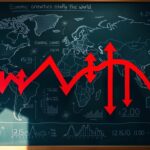Corporate strategy frameworks aren’t working for businesses as they should. 74% of firms struggle to implement their plans, even with a strategy.
Sentiment differs around the world (95% in the UK, Singapore, and Hong Kong compared to 87% in Australia), but the dangers companies face keep changing. These days, cyber threats, supply chain issues, and climate change are the main systemic risks affecting how businesses work across industries. On top of that, the state of the economy, keeping talented employees, and changes in regulations are big risks for businesses in the near future through 2027.
We’ve spotted 13 strategic planning frameworks built to help your company tackle these tricky challenges. From old-school tools like SWOT analysis to more all-encompassing approaches like Enterprise Risk Management (ERM), these strategic management frameworks offer structured ways to spot, evaluate, and reduce strategy risks. Each strategic analysis framework has its perks depending on your specific market hurdles and company setup.
SWOT Analysis

Image Source: BiteSize Learning
SWOT analysis acts as a basic corporate strategy framework that aids organizations in assessing internal and external factors affecting their performance. This structured approach allows businesses to make smart choices about their strategic direction while identifying possible risks.
SWOT Analysis overview
SWOT means Strengths, Weaknesses, Opportunities, and Threats. This strategic analysis method categorizes factors into two groups: internal aspects, which include strengths and weaknesses, and external aspects, which encompass opportunities and threats. Strengths are internal qualities that help achieve success, like talented staff or cutting-edge tech. Weaknesses include internal problems that might hurt performance, such as skill shortages or limited resources. Opportunities consist of external factors companies can use to their advantage, while threats are external challenges that risk business success.
Why SWOT Analysis works for market risks
SWOT analysis is useful in risk management. It has an impact on combining internal assessments with external environment scans in a single structured matrix. Furthermore, it helps uncover risks by looking at both internal abilities and external threats at the same time. This method aids in spotting risks during strategy planning. It does this by asking questions about internal weak points that might slow down projects or external threats that could throw off goals. As a result, companies can rank risks based on how likely they are to happen and how big their effect might be. High-impact threats tied to key weak spots need quick action. On the flip side, chances that match up with strong points can act as possible cushions against risks.
How to use SWOT Analysis
To use SWOT analysis well:
- Get the right people involved—bring in team members from different areas who know a lot about the topic being looked at
- Please initiate a group brainstorming session, starting with strengths. Ask people to jot down ideas before sharing. This step stops everyone from thinking the same way.
- Please review and combine ideas by grouping similar points together. Put them in order from most to least important.
- Link strategies—use strong points to fix weak areas or lessen threats. Take advantage of chances to reduce risks.
- Make plans to act. Turn insights into real strategies to handle risks. Add these to your risk list.
Regular SWOT checkups (every three or six months) help companies stay alert to new risks and chances that might come up. This makes it a key part of ongoing planning frameworks.
Porter’s Five Forces

Image Source: Investopedia
Porter’s Five Forces is one of the strongest business strategy tools to examine competition and strategic risk. Unlike broader frameworks, it zeros in on industry factors that shape how intense competition is and how attractive markets are.
Porter’s Five Forces explained
This strategy analysis tool looks at five key market forces:
Competitive Rivalry—How fierce the competition is between existing companies affects their ability to set prices and keep market share stable. Industries with many competitors of about the same size face tougher competitive pressure.
Supplier Power—Businesses face operational and cost risks when suppliers can dictate decisions, raise prices, or reduce quality without facing resistance. Supplier markets with few players boost this power.
Buyer Power—Strong buyers can push for lower prices or better quality, cutting into profit margins. This power grows when there are few buyers, they buy in bulk, or they can change suppliers without much hassle.
Threat of Substitution—Other products or services that meet similar needs set price limits and can shrink the market. The digital age has made this force stronger across many industries.
Threat of New Entrants—When it’s easy to enter a market, there’s a higher risk of competition. Things that make it harder to enter include needing lots of money, dealing with rules, building brand trust, and being able to produce at a large scale.
How it helps spot competitive risks
Porter’s model shines at uncovering hidden competitive risks that other strategic planning tools might overlook. Plus, it has a structured approach to analyze external pressures beyond your control. The framework helps predict how competitors might react to market shifts, which allows for proactive risk management.
Unlike SWOT analysis, which gives a broad overview, Porter’s Five Forces digs deeper into competitive dynamics, offering insights into both current and future market risks.
How to apply Porter’s model in 2025
To put this strategic management framework into action in today’s world:
- Rate each force on a 1-5 scale to quantify competitive pressure
- Spot digital disruptors in your industry that might redefine traditional force relationships
- Chart industry-specific ESG factors that shape competitive dynamics
- Come up with strategy plans based on changes in forces (like when suppliers merge)
- Create specific defense and attack plans for each high-risk force
The model still holds up well even though it’s from 1979. To use it today, you need to think about how platforms work in the economy, how data gives companies an edge, and how competition happens across whole ecosystems, not just within industries.
Balanced Scorecard

Image Source: Balanced Scorecard Institute
The balanced scorecard turns big-picture company goals into actions you can measure. This makes it a key tool for businesses dealing with shaky markets. Robert Kaplan and David Norton came up with this idea in the 1990s. Since then, it’s grown into a full system to manage strategy, not just a way to measure things.
Balanced Scorecard framework basics
The name “balanced scorecard” shows its main goal—to give a more complete picture of how well a company is doing, not just looking at money matters. This way of managing a business looks at four important areas:
- Financial Perspective: Looks at how the company is doing with money and using its resources
- Customer/Stakeholder Perspective: Checks how well the company is doing from the customer’s point of view
- Internal Process Perspective: Looks at how good and efficient the main business activities are
- Organizational Capacity: Examines the skills of people, the tools they use, and the way things are done in the company
A strategy map shows connections between goals, making clear how different parts of an organization work together. This picture helps bosses see how projects, measurements (KPIs), key aims, and the company’s mission all fit together.
How it helps keep everything on track
The balanced scorecard is excellent at reducing strategy risks by connecting big-picture ideas to everyday work. Studies from around the world show it’s the fifth most popular management tool out there.
At first, the framework assists companies in turning their strategy into concrete goals and measurements. Next, it ensures that the use of resources aligns with key strategic objectives. The system includes risk management—each strategic goal can spot related risks through the strategy map that shows how value is created.
Steps to put the Balanced Scorecard into action
Following the Nine Steps to Success™ method, the rollout goes like this:
- Set the strategy—make mission, vision, values, and strategic goals clear
- Create objectives—Develop specific objectives for all four areas
- Build a strategy map—show how objectives link to and affect each other
- Choose performance measures—set up KPIs to check progress
- Choose key projects—focus on initiatives that produce results
- Spread across the company—adapt high-level plans to teams and employees
- Keep an eye on progress—set up ways to collect and examine data
In the end, putting a Balanced Scorecard into action takes about two to four months based on company size, but it’s an ongoing process rather than a one-off task.
Blue Ocean Strategy

Image Source: Blue Ocean Strategy
Blue Ocean Strategy breaks away from typical business planning methods by zeroing in on untapped markets rather than fighting rivals. W. Chan Kim and Renée Mauborgne came up with this idea, which gives companies ways to break free from packed markets and spot chances to grow.
What is Blue Ocean Strategy
Blue Ocean Strategy splits the business world into two different areas: red and blue oceans. Red oceans stand for existing industries with clear boundaries where companies compete for market share, often leading to fierce competition. On the other hand, blue oceans represent unexplored market spaces free from competition. This approach challenges the usual trade-off between value and cost, aiming to achieve both uniqueness and low cost at the same time. In fact, research indicates that while 14% of business launches focused on creating new markets, they produced an impressive 61% of total profits.
Why it reduces competitive risk
This strategic analysis framework lowers risk by making competition irrelevant. Rather than fighting in crowded markets where products become commodities and price wars eat into profits, Blue Ocean Strategy generates new demand. As a result, companies avoid the downward spiral of dwindling profit margins and brand sameness that defines red oceans. The method aligns three key propositions: value, profit, and people, resulting in a mutually beneficial outcome for customers, the company, and stakeholders. In essence, it offers a way out of the 90% business failure rate within ten years.
How to create a Blue Ocean in 2025
To create a blue ocean in today’s market, you need a step-by-step plan using the Four Actions Framework—Eliminate, Reduce, Raise, and Create. Start by picking the right scope for your blue ocean project and boosting your team’s confidence. Next, understand the current strategic scene. Then, spot hidden limits that could turn into chances. After that, come up with practical Next, utilize the six paths framework to devise feasible blue ocean options and test your strategy in the market before launching it. Through breakthroughs and shifting customer preferences, companies that shape their industries instead of simply reacting to change will emerge victorious.
Ansoff Matrix

Image Source: Corporate Finance Institute
Mathematician H. Igor Ansoff created the Ansoff Matrix in 1957 to give companies a way to look at growth options and their risks. The Harvard Business Review first published this plan, which still helps organizations decide how to grow.
Ansoff Matrix structure
The Ansoff Matrix looks like a 2×2 grid. It matches current and new products with current and new markets. This creates four different ways to grow:
- Market Penetration—Selling current products to existing markets through more marketing, deals, or buying competitors. This plan has the lowest risk because it uses familiar ground.
- Market Development—Bringing current products to new markets, either by expanding to new areas, aiming at different groups of people, or trying new ways to sell goods.
- Product Development—Making excellent products for current markets using strong customer ties and market know-how while putting money into new ideas.
- Diversification—launching new products Diversification involves introducing new products into unexplored markets, posing the greatest risk but potentially yielding the greatest rewards. We categorize this approach into two types: related diversification, which aligns with the current business, and unrelated diversification, which involves entirely new ventures.
Why it helps with growth risk
This strategic analysis framework’s main benefit is its organized risk evaluation. Each section shows increasing risk levels, helping companies balance bold moves with caution. Market penetration has the lowest risk because both the product and the market are familiar, while diversification carries the highest risk because both elements are new territory.
The matrix also spots possible team-ups between strategies. For example, a company might push into current markets to fund riskier new product efforts. The framework brings strategic focus by making leaders spell out if they’re after small improvements or significant changes in growth.
How to use significant changes six
To put this strategic management framework into action:
- Check where you stand now, looking at your current products and markets
- Figure out what you’re good at and what resources you have
- Look at what’s happening in the market—both good and bad
- Rate each way you could grow based on your specific situation
- Pick strategies that match how much risk you’re okay with and what you want for your business
To ensure success, thoroughly research the market, be truthful about your capabilities, and identify your top priorities. This approach works best when you use it along with other tools like SWOT or Porter’s Five Forces. These help you see both if you’re ready inside your company and what chances are out there.
BCG Matrix

Image Source: Leland
The Boston Consulting Group (BCG) Matrix is a key corporate strategy tool that helps companies assess their product lineup based on market growth and relative market share. BCG created this strategic analysis framework in 1970, and at the peak of its popularity, about half of all Fortune 500 companies used it.
Understanding the BCG Matrix
The BCG Matrix puts products into a 2×2 grid. The vertical axis shows market growth rate, while the horizontal axis indicates relative market share. This setup results in four distinct sections:
- Stars—Products that dominate high-growth markets, bringing in lots of money but needing big investments to stay on top
- Cash Cows—Leading products in slow-growth markets that make money without needing much extra investment
- Question Marks—Products with a small slice of fast-growing markets that eat up resources but might or might not pay off
- Dogs—products with a tiny share of slow-growth markets that just break even or make a little money
The horizontal line shows how much of the market a product has compared to its rivals, which tells you how strong it is. The up-and-down line shows how fast the market is growing, with 10% splitting rapidly from slow growth.
How it helps manage risk in a product mix
This strategic planning tool has a strong impact on managing portfolio risks by showing product performance across various market situations. Cash cows fund growth projects while needing little investment. Stars require protection and investment to keep their top spot as markets grow.
The matrix helps balance risk by spreading it across different areas. It also prevents excessive investment in declining products by identifying those that may require sale. In the end, this tool helps put limited resources where they’ll bring the best returns.
How to use BCG Matrix in 2025
To put this strategic management tool into action:
- Collect thorough information on how each product’s market share compares to your biggest rival
- Examine current and expected growth rates for every market segment
- Place products on the matrix using these two factors
- Create suitable plans for each section. put money into stars, milk cash cows, assess question marks, and think about getting rid of dogs
- Add in new elements like digital shake-ups, effects on sustainability, and competition within ecosystems
Let’s acknowledge that the traditional matrix has its limitations—it oversimplifies complex market forces and fails to consider the potential interdependence of products. Still, when you pair it with other ways to plan, it’s still a great tool to look at your product mix and handle risks.
Value Chain Analysis

Image Source: Sloovi
Value chain analysis influences corporate strategy. It looks at all the steps needed to make a product or service and get it to customers. Michael Porter came up with this idea. It breaks down business processes to find ways to create value and spot weak points in operations.
Value Chain Analysis overview
Value chain analysis splits a company’s work into two main parts: primary and support activities. Together, these create value. Primary activities help with making and delivering products. These include bringing in materials, making things, sending out products, marketing, and customer service. Support activities make primary activities work better. These include buying supplies, developing technology, managing people, and running the company. The main goal is to give customers the most value while spending the least money. This approach helps companies stand out from their rivals.
Why it spots operational risks
Value chain analysis is excellent at finding weak spots in operations by looking at how each step adds to the final product. Companies that do full value chain reviews can spot possible breakdowns across their supply networks. Currently, businesses are facing big risks in their operations—on average, across different industries, companies expect supply chain problems lasting a month or longer to happen every 3.7 years. These issues can hurt money-making, with one long production problem wiping out between 30% and 50% of a year’s EBITDA for most companies.
How to do a Value Chain Analysis
To carry out value chain analysis well:
- Find all value chain activities—chart both main and supporting processes that help create your product or service.
- Figure out values and costs—look at what each activity adds to customer value and how much it costs.
- Study cost drivers— Get to know what affects costs for each activity, like work hours, how fast you produce, or how excellent your materials are.
- Spot links between activities—see how making one area better might change others, as cutting costs in one job can lead to saving money in the next ones.
- Find ways to improve. List tasks that can be made easier or safer and more valuable with machines.
Using this approach to strategic analysis allows companies to boost their performance and prepare for possible setbacks. It helps them run more and stand strong when challenges arise.
PEST Analysis

Image Source: NC State ERM Initiative—NC State University
PEST analysis influences how companies assess external macro-environmental factors that might affect their strategic choices. This framework looks at broad market forces outside a company’s control, giving key insights to navigate uncertainty in complex markets.
PEST Analysis components
PEST stands for political, economic, social, and technological factors that shape the business scene.
- Political factors cover government rules, trade laws, political steadiness, tax policies, job laws, and rule changes that can affect how a business runs.
- Economic factors include how fast the economy grows, price hikes, interest rates, changes in money value, how well supply chains work, and how people spend their money. These things shape buying power and business costs.
- Social factors involve changes in the population, where people live, cultural views, how consumers act, social trends, and shifts in lifestyle. These affect what people want to buy and who’s available to work.
- Technological factors examine new ideas, automation of jobs, digital advancements, concerns about online safety, and emerging technologies that could alter industry operations or introduce new competition.
Many companies use a bigger version called PESTLE. This adds legal and environmental parts to get a fuller picture.
Why it helps to scan external risks
PEST analysis has become crucial as it offers a clear structure to spot potential threats before they show up. Companies that do PEST checks get an early heads-up about changes, letting them act instead of just react. Currently, businesses think supply chain problems lasting a month or more will happen every 3.7 years. At its core, this strategic review method helps firms grasp how outside changes might affect their business plan and key goals.
How to use PEST for strategic planning
To put PEST analysis into action:
- Define clear scope—pin down the industry, sector, or market you’re looking at
- Assemble cross-functional team—bring in experts from different departments to get varied views
- Identify relevant factors—dig up and gather data about each PEST element
- Analyze potential impacts—figure out how identified factors might affect your operations
- Categorize and prioritize—zero in on factors that will have a big impact on your business
- Develop responsive strategies—come up with doable plans to address each critical factor
As a rule, companies should do a PEST analysis twice a year or at least once a year to keep up with market trends.
McKinsey 7S Model

Image Source: Pro Study Lab
McKinsey consultants created the McKinsey 7S Model in the late 1970s to examine how well organizations work through seven connected parts, not just structure. This business strategy tool has stayed useful for over 40 years because it knows that big improvements in one area are tough without working on others.
McKinsey 7S elements
The model splits seven company parts into two groups:
Hard Elements (easier to see and control by managers):
- Strategy—The plan to gain an edge over competitors and reach goals
- Structure—How the company is set up, including jobs and levels
- Systems—everyday tasks, steps, and methods people follow
Soft Elements (more abstract and rooted in culture):
- Shared Values—Core beliefs that drive behavior at the heart of the model
- Skills—abilities and expertise within the organization
- Style—How leaders lead and managers manage
- Staff—People resources, including hiring and growth
The visual typically displays shared values at the center, illustrating how company culture influences all other components.
How it keeps things in sync inside
The 7S Model tackles strategy risks by spotting mismatches that slow progress. For example, when structure doesn’t fit strategy or when leadership style clashes with shared values, it can throw off plans. In real life, companies that use this framework get a big-picture view of how things connect, which is key during times of change.
So, the model’s main worth is in its all-around method of coordination instead of hierarchy. By looking at each part, teams can spot differences and build unified plans for smooth changes.
How to use the 7S Model in 2025
To effectively utilize this strategic planning tool, follow these steps:
- Check the current state across all seven areas
- Find gaps between now and where you want to be
- Study the best organizational design
- Make a detailed plan to implement changes
- Make changes happen with strong support from leaders
- Set up ways to keep reviewing
All in all, the 7S Model offers a strong way to make sure every part of your organization helps others, leading to better work and a clearer focus on strategic goals.
Objectives and Key Results (OKRs)

Image Source: Tability
The Objectives and Key Results (OKRs) framework connects strategy creation and implementation, enabling companies to implement plans while monitoring potential risks. Intel made it popular first, then Google picked it up, and now this method is used across different industries because it works well to sharpen strategic focus.
What are OKRs
OKRs have two main parts that work together. Objectives show what you want to do—they should be important, push you to act, and fire you up. Key results track how you’re doing on objectives with clear, timed, and checkable numbers. Unlike traditional goal-setting methods, OKRs encourage you to aim high, with the ideal range for achieving targets being 60-70%. If teams always hit 100%, their goals are too easy.
How OKRs make goals clearer
OKRs significantly enhance clarity in multiple ways. First, they help align strategy by linking individual work to company goals. Second, they boost openness by making goals clear to everyone in the company. Third, they allow focused action by prioritizing tasks that have the most impact on the business. Through these methods, OKRs change how organizations think, moving from focusing on outputs (finished tasks) to outcomes (achieved results).
How to put OKRs into action to reduce risk
To implement OKRs for managing risk, you need to follow these key steps:
- Set your strategy first—OKRs turn strategy into action, not replace it
- Get leaders on board—they need to show how to use OKRs
- Pick the right timing—yearly for the whole company, every three months for teams
- Check in often—weekly reviews. stop off-track goals from causing problems
- Mix growth and quality goals—pair targets for growth with ways to measure quality to avoid missing key risks
Currently, OKRs assist companies in managing risk by providing real-time tracking and monitoring. As you put them into practice, keep in mind that OKRs balance avoiding risks with taking needed ones. In the end, they create a system where big goals can exist alongside careful risk management, letting companies grow while staying on track with their strategy.
Scenario Planning

Image Source: Prophix
“Consider how your decisions will foster—or inhibit—long-term growth no matter the political climate, and strive to act in the best interest of your company’s future.” — Diligent Editorial Team Corporate governance and risk management analysts
Scenario planning is a straightforward yet effective corporate strategy framework that helps companies deal with future uncertainties instead of trying to predict them. This strategic planning framework doesn’t react to situations but creates different views of potential futures. This approach allows businesses to get ready for various possibilities.
Scenario Planning definition
Scenario planning organizes external, uncontrollable, and unpredictable factors into a structured planning framework. The U.S. military first developed this approach, and corporations later adopted it. This method doesn’t try to predict exact outcomes but instead develops plausible alternative futures. At its heart, scenario planning shifts the focus from forecasting specific events to understanding the dynamics that will shape future business environments. This strategic analysis framework helps organizations to visualize different representations based on assumptions about market-driving forces.
Why it prepares for uncertainty
Organizations face inevitable uncertainty—data shows companies now expect supply chain disruptions lasting a month or longer to occur every 3.7 years. Scenario planning helps to manage these risks by
- Spotting potential risks and chances before they show up
- Putting current plans to the test against possible futures
- Giving quick insights on choices way ahead of when they’re needed
- Making strategy flexible so it can change as things unfold
- Helping the company stand strong when surprises happen
In real life, scenario planning gives bosses and boards a way to improve non-urgent choices by showing what might happen down the road.
How to create strategic scenarios
To put effective scenario planning into action, you need to:
- Frame the core question—figure out what you need to know to make your organization ready for future challenges
- Identify driving forces—look at political, economic, social, technological, legal, and environmental factors
- Determine critical uncertainties—pick the two factors that have the biggest impact and are hardest to predict
- Develop scenario matrix—create four possible scenarios based on how these uncertainties might work together
- Analyze implications—think about how each scenario could affect your organization’s plans
- Develop robust strategies—find “low regret” approaches that work well in multiple scenarios
Scenario planning helps organizations get ready for uncertainty without needing to predict the future—just a step-by-step way to think about possible outcomes.
Strategic Risk Mapping

Image Source: FasterCapital
Strategic risk mapping offers a visual structure that turns complex risk data into useful insights. This business strategy tool helps companies rank threats based on how likely they are to happen and how much damage they could cause. This approach allows for better use of resources to reduce risks.
What is strategic risk mapping?
Strategic risk mapping shows threats on a chart based on two key factors: how often they might happen and how serious they could be. This method pinpoints the dangers that could hurt a company’s plans and goals. Companies utilize a colored grid to identify their primary risks, which occur frequently and pose significant problems; monitor other risks, which occur frequently but do not pose significant problems; and maintain a low level of concern for the remaining risks.
Why it shows risk exposure
Risk maps have many benefits compared to standard risk lists. For one, they turn complex risk info into an easy-to-grasp, color-coded grid that shows the risk landscape at a glance. Furthermore, these visual aids help people discuss threats better by giving them a shared visual way to discuss risks. The clear split of risk levels through color coding—red, yellow, and green—makes it clear right away which areas need quick action. This picture-based method boosts risk awareness at all company levels while making analysis stronger by bringing all the data together.
How to create a risk map
To make a successful strategic risk map, you need to follow these main steps:
- Find all possible risks that could affect your company by brainstorming with people from different departments
- Look at each risk on its own to see how likely it is to happen and how bad it could be
- Put the risks on the chart based on their scores for both factors
- Use colors to show how serious each risk is—red for the worst ones. yellow for medium ones green for less important ones
- Create plans to handle the biggest risks, including specific steps, who’s in charge, and when things need to be done
- Check and update often as new risks pop up and old ones change
This approach ensures that you allocate your resources to address the most significant threats first while simultaneously monitoring potential new risks.
Enterprise Risk Management (ERM)

Image Source: TrustCommunity—TrustCloud
Enterprise Risk Management (ERM) takes a big-picture view that brings together risk spotting, sizing up, and handling at every level of a company. Unlike more limited setups, ERM looks at all kinds of risks to help make smart choices for the whole business.
ERM framework overview
ERM gives a clear picture of all the risks that can affect an organization’s mission. The COSO framework, which many industries use, links risk management to strategic choices and business results. This approach looks at governance, culture, strategy, performance, and reporting in a big-picture way. Some organizations might pick ISO 31000 or NIST frameworks based on what their industry needs. Above all, a well-designed ERM program transforms risk management from a mere checklist into a crucial component of strategy, fostering innovative ideas and prompt decision-making.
Why ERM is essential for 2025
Currently, companies expect big supply chain problems that last a month or more to happen every 3.7 years. These issues can hurt moneymaking by erasing 30–50% of one year’s EBITDA. But beyond just playing defense, ERM boosts business results—companies with strong ERM plans are twice as likely to see better financial outcomes. Through 2025, AI will improve ERM by spotting fraud, doing routine jobs, and making it simpler to follow rules. This teamwork lets companies see risks coming instead of just dealing with them after they happen.
How to make ERM part of your plan
To put ERM into action well, follow these main steps:
- Context Understanding: Set strategic goals and create clear risk guidelines that match your company’s mission
- Risk Identification: Use different tools and methods to find possible threats in compliance, operations, and strategy areas
- Business Integration: Make ERM practices part of daily work, long-term planning, and how decisions are made
- Continuous Discipline: Make ERM an ongoing habit with regular checks and updates to keep up with changing risk environments
As you put this into action, use tech platforms to bring risk data together, automate assessments, and create useful reports that give a complete picture of risks across your company.
Comparison Table
| Framework | Main Goal | Core Elements | Top Advantages | Steps to Put in Place |
|---|---|---|---|---|
| SWOT Analysis | To assess internal and external factors that affect performance | Strengths, Weaknesses, Opportunities, Threats | It blends internal checks with external scans; It helps spot risks | 1. Rate each force (1-5). 2. Find digital disruptors. 3. Map ESG factors 4. Create strategy scenarios. 5. Build specific strategies |
| Porter’s Five Forces | To study competition and strategic risk | Competition in the Market, Power of Suppliers, Power of Buyers, Risk of Substitutes, Risk of New Players | It uncovers hidden competitive risks; It offers a clear way to analyze outside pressures | 1. Set strategy 2. Choose goals. 3. Create a strategy map. 4. Pick measures. 5. Choose initiatives. 6. Spread throughout company 7. Watch performance |
| Balanced Scorecard | To turn vision into measurable action | Money, Customers/Stakeholders, Internal Process, Company Ability | It creates clear links between vision and daily work; It includes risk management | 1. Pick a scope. 2. Check the strategic landscape. 3. Find limits. 4. Create options. 5. Test and start |
| Blue Ocean Strategy | To create new market space | Red Oceans (current markets), Blue Oceans (new markets), Four Actions Framework | It cuts competitive risk; It creates new demand; It avoids price wars | 1. Check the current spot. 2. Review abilities. 3. Study chances 4. Score growth plans 5. Pick matching strategies |
| Ansoff Matrix | To weigh growth options against risks | Market Penetration, Market Growth, Product Growth, Diversification | It offers a structured risk check; It shows increasing risk levels; It helps find shared benefits | It balances portfolio risks, it helps assign resources, and it stops overinvestment. |
| BCG Matrix | To check product portfolio performance | Stars, Cash Cows, Question Marks, Dogs | It balances portfolio risks, it helps assign resources, and it stops overinvestment. | Political, Economic, Social, Technological Factors |
| Value Chain Analysis | To study activities that create value | Main Activities, Support Activities | It finds weak spots in operations; It spots chances to improve | 1. Find activities. 2. Set values/costs. 3. Study cost drivers 4. Find links 5. Spot improvements |
| PEST Analysis | To check big-picture factors | 1. Set scope 2. Build a team. 3. Find factors. 4. Study impacts 5. Sort/rank 6. Make strategies | 1. Set scope 2. Build a team. 3. Find factors 4. Study impacts 5. Sort/rank 6. Make strategies | 1. Set scope 2. Build a team. 3. Find factors. 4. Study impacts 5. Sort/rank 6. Make strategies |
| McKinsey 7S Model | To check how well the company works | Strategy, Structure, Systems, Shared Values, Skills, Style, Staff | It shows misalignments; It gives a full view | 1. Study current |
Conclusion
Market risks require structured responses, not reactive panic. This article has explored 13 powerful corporate strategy frameworks designed to help organizations overcome the complicated obstacles that await 2025 and beyond. Each framework offers unique benefits depending on your specific organizational context and risk profile.
Instead of seeing these frameworks as competing approaches, consider them complementary tools in your strategic toolbox. Analysis provides that crucial foundation to understand both internal capabilities and external threats. Then, Porter’s Five Forces delivers deeper competitive insights, while the Balanced Scorecard turns abstract vision into measurable action. This means frameworks like Blue Ocean Strategy and the Ansoff Matrix help evaluate growth opportunities against inherent risks.
The key to success for organizations isn’t picking one framework and sticking to it. Instead, they combine various approaches to gain a comprehensive understanding of their strategy. The BCG Matrix can help you figure out which products to focus on, while Value Chain Analysis shows where your operations might be weak. Additionally, PEST analysis keeps you informed about significant market changes that could either negatively or positively impact your business.
All these frameworks have one main job: to turn unknowns into risks you can handle. The market will keep changing a lot through 2025, but companies that use these strategy tools can make smart choices instead of just reacting. Sure, setting up excellent frameworks takes time and money at first, but it pays off by making your business stronger and giving you an edge over competitors.
We suggest you start with frameworks that tackle your biggest strategic issues and then build up your toolkit as your organization gets better at using them. Remember, frameworks are designed to support your strategy, not the other way around. The real strength isn’t in following frameworks but in how well these tools help your company predict, adjust to, and beat market risks while chasing strategic goals.
Which strategic frameworks have worked best for your company? What frameworks are you planning to use as you get ready for the challenges of 2025 and beyond?
FAQs
Q1. What are the key risk trends organizations should prepare for in 2025?
Organizations should ready themselves for cyber threats, responsible AI use, worker engagement, cutting-edge risk tech, and active climate risk handling to navigate the changing risk scene of 2025.
Q2. Which risk management frameworks do companies use most?
Common risk management frameworks include the COSO ERM Framework, ISO 31000 Risk Management Standard, NIST Cybersecurity Framework, ITIL Service Lifecycle, and OCTAVE Allegro. Each offers unique ways to spot and reduce risks.
Q3. How can companies align risk management with their overall strategy?
Smart corporate risk management looks at possible dangers in light of what’s important to the business. When companies match up risk and strategy, they can make better choices about taking chances and try new things with more confidence.
Q4. Why do companies use a Risk Management Framework (RMF)?
A risk management framework provides companies with a clear method to identify, evaluate, mitigate, and monitor risks. It helps blend security, privacy, and rule-following into how things work to guard against threats and legal issues.
Q5. How often should companies look over and fix their big-picture risk checks?
Although timeframes can differ, companies should review their risk assessments on a regular basis. Many specialists suggest doing this every three or six months, with more frequent checks in fast-changing fields or during times of big market swings.









































































































